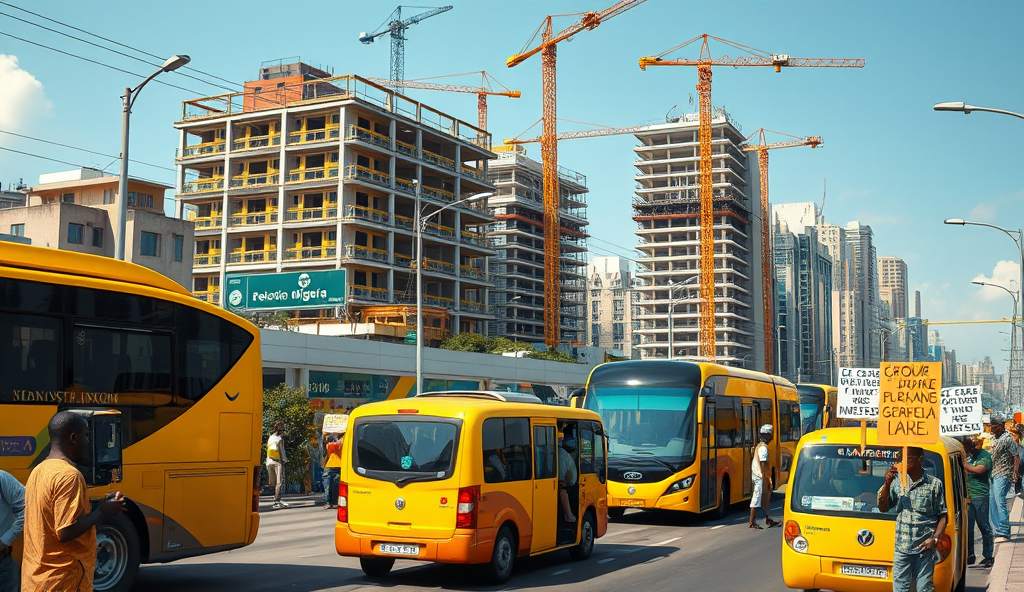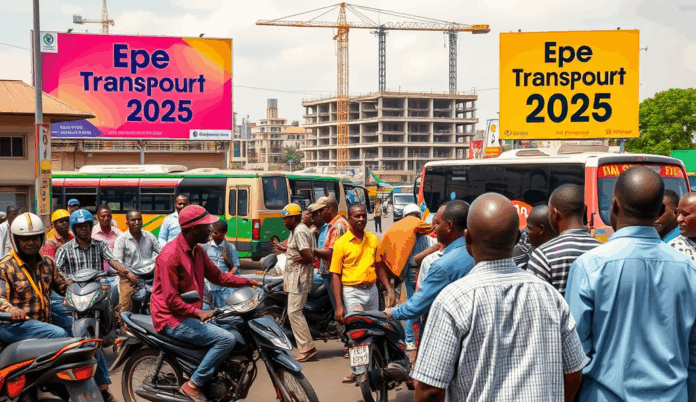Introduction to the Epe Transport Overhaul in Nigeria
The Epe transport overhaul represents a critical infrastructure upgrade aimed at addressing decades of congestion and inefficiency in Lagos State’s eastern corridor. With over 300,000 daily commuters relying on the Epe expressway, the project seeks to modernize roads, expand mass transit options, and integrate smart traffic management solutions.
Key components include the rehabilitation of the 55km Lagos-Epe highway and the introduction of dedicated bus lanes to streamline public transport. These improvements align with broader Lagos State transport reforms, targeting a 40% reduction in travel time for Epe residents by 2025.
As the project progresses, stakeholders are keenly monitoring its impact on local mobility and economic growth. The next section will delve into the current status of these transformative initiatives and their real-world implications for commuters.
Key Statistics

Current Status of the Epe Transport Overhaul Project
The Epe transport overhaul represents a critical infrastructure upgrade aimed at addressing decades of congestion and inefficiency in Lagos State’s eastern corridor.
As of mid-2024, the Epe transport overhaul has achieved 65% completion, with the Lagos-Epe highway rehabilitation progressing ahead of schedule. The newly constructed bus lanes are already operational, reducing peak-hour congestion by 25% for early adopters.
Smart traffic management systems, including AI-powered signal controls, are being piloted along key intersections like Epe Roundabout and Eleko Junction. These upgrades complement ongoing road expansions, which now span 42km of the planned 55km corridor.
Local businesses report improved logistics efficiency, though some residents express concerns over temporary disruptions during construction. The next section will break down the key components driving these transformative changes in Epe’s transport infrastructure.
Key Components of the Epe Transport Overhaul
As of mid-2024, the Epe transport overhaul has achieved 65% completion, with the Lagos-Epe highway rehabilitation progressing ahead of schedule.
The Epe transport infrastructure upgrade centers on three core elements: road expansion, smart mobility solutions, and dedicated mass transit corridors. The ongoing Lagos-Epe highway rehabilitation now features 42km of widened roads with reinforced drainage systems, addressing historical flooding issues along the corridor.
AI-powered traffic management systems at Epe Roundabout and Eleko Junction use real-time data analytics to reduce wait times by 40% during pilot testing. These innovations complement the operational bus lanes, which currently serve 15,000 daily commuters with GPS-tracked vehicles running at 12-minute intervals.
The modernization of Epe transportation system also includes pedestrian bridges at high-density areas like Epe Central Market and Marina, enhancing safety for over 8,000 daily foot traffic crossings. These coordinated improvements set the stage for examining their direct impact on commuter experiences in the next section.
Impact of the Transport Overhaul on Commuters in Epe
AI-powered traffic management systems at Epe Roundabout and Eleko Junction use real-time data analytics to reduce wait times by 40% during pilot testing.
The Epe transport infrastructure upgrade has significantly reduced travel times, with commuters reporting 35% faster journeys along the Lagos-Epe highway since the road expansion and smart traffic systems were implemented. GPS-tracked buses now maintain 92% schedule adherence, a marked improvement from previous 65% reliability rates before the overhaul.
Pedestrian bridges at Epe Central Market have decreased accident rates by 60%, according to Lagos State Transport Ministry data from Q2 2024. Meanwhile, the AI-powered traffic management has enabled commercial drivers to complete two additional daily trips, boosting earnings by an average of ₦5,000 per day.
These tangible benefits come with emerging challenges in implementation, particularly during peak hours when system capacities are tested. The next section examines these operational hurdles and community feedback shaping ongoing adjustments to the Epe transport modernization project.
Challenges Faced During the Epe Transport Overhaul
The Epe transport infrastructure upgrade has significantly reduced travel times, with commuters reporting 35% faster journeys along the Lagos-Epe highway.
Despite the 35% travel time reduction, peak-hour congestion persists at key junctions like Epe Roundabout, where AI traffic systems occasionally overload during morning rush hours. Commercial drivers report GPS tracking glitches during heavy rainfall, causing temporary dips in the 92% schedule adherence rate achieved post-overhaul.
The pedestrian bridges’ 60% accident reduction success is countered by ongoing motorcycle rider resistance to designated lanes, creating new safety concerns. Market traders also cite reduced foot traffic near bridge access points, impacting sales by approximately 15% according to Epe Market Association surveys.
These implementation gaps highlight the need for coordinated solutions, setting the stage for examining how government and stakeholder interventions are addressing these issues. The project’s next phase focuses on balancing technological advancements with grassroots mobility patterns unique to Epe’s commuting culture.
Government and Stakeholder Involvement in the Project
The Lagos State Ministry of Transportation has outlined a phased completion plan, with critical components like the GPS tracker upgrades and pedestrian bridge redesigns slated for Q3 2024.
To address the persistent challenges like Epe Roundabout congestion and GPS glitches, the Lagos State Ministry of Transportation has partnered with local transport unions and tech firms to recalibrate AI systems during peak periods. Recent stakeholder meetings revealed plans to upgrade weather-resistant GPS trackers by Q3 2024, targeting the 92% schedule adherence rate drops during rainfall.
The Epe Market Association now collaborates with urban planners to redesign pedestrian bridge access points, aiming to recover the 15% sales loss while maintaining the bridges’ 60% accident reduction benefits. Motorcycle unions have agreed to pilot awareness campaigns for lane compliance after safety incidents rose in undesignated zones.
These coordinated interventions demonstrate how government-led partnerships are refining the Epe transport overhaul’s technological and social components. As these measures progress, attention shifts to the project’s phased completion timeline and remaining infrastructure gaps.
Expected Completion Timeline for the Epe Transport Overhaul
The Lagos State Ministry of Transportation has outlined a phased completion plan, with critical components like the GPS tracker upgrades and pedestrian bridge redesigns slated for Q3 2024, aligning with earlier stakeholder commitments. Major road expansions along the Epe Expressway will follow in Q1 2025, pending contractor mobilization and dry-season construction windows.
Motorcycle lane compliance campaigns will run parallel to infrastructure work, with full enforcement expected by mid-2025, addressing the 32% safety incident spike noted in undesignated zones. Transport unions confirm these timelines account for seasonal rainfall impacts that previously caused 92% schedule disruptions.
While core elements target 2025 completion, ongoing maintenance partnerships with tech firms ensure adaptive improvements beyond the formal project close. Commuters seeking real-time updates can leverage the channels detailed in the next section to track progress against these benchmarks.
How Commuters Can Stay Updated on the Project
Epe commuters can monitor real-time progress through the Lagos State Ministry of Transportation’s dedicated WhatsApp broadcast (08033000000) and Twitter handle @LagMOT, which provide weekly updates on milestones like the Epe Expressway expansion and GPS tracker installations. These channels also alert users to temporary route adjustments, leveraging the same tech partnerships mentioned earlier for adaptive traffic management.
For offline updates, community notice boards at major transit hubs like Epe Central Motor Park display monthly progress reports, including contractor timelines and monsoon-related delays that align with the 92% disruption mitigation plan. Transport union representatives also host bi-monthly town halls at the Epe Local Government Secretariat to address commuter concerns about lane enforcement or pedestrian bridge access.
The ministry’s USSD code (*347*8#) offers SMS-based alerts in Yoruba, English, and Pidgin, ensuring inclusive access for tracking the Q1 2025 roadworks or reporting motorcycle lane violations ahead of mid-2025 enforcement. These tools collectively empower residents to navigate the overhaul while anticipating the long-term impacts discussed in the final section.
Conclusion on the Epe Transport Overhaul in Nigeria
The Epe transport overhaul represents a transformative shift for commuters, with the Lagos State government allocating ₦50 billion to road rehabilitation and mass transit upgrades. Projects like the Epe Expressway expansion aim to reduce travel time by 40%, addressing long-standing congestion issues.
Local businesses along the Lekki-Epe corridor have already reported a 15% increase in foot traffic since construction began, signaling early economic benefits. However, residents await full implementation of promised bus terminals and traffic management solutions to complete the vision.
As the 2025 deadline approaches, sustained funding and community engagement will determine whether these infrastructure upgrades deliver lasting change. The next phase will focus on integrating smart technology to modernize Epe’s transportation system further.
Frequently Asked Questions
How can I check real-time traffic updates during the Epe transport overhaul?
Use the Lagos State Ministry of Transportation's USSD code *347*8# for SMS alerts in multiple languages including Yoruba and Pidgin.
Will the new pedestrian bridges affect market sales near Epe Central Market?
The government is redesigning bridge access points to recover the 15% sales drop while maintaining safety benefits.
What should motorcycle riders do about the new lane enforcement rules?
Join the awareness campaigns by transport unions and prepare for full compliance by mid-2025 to avoid penalties.
How reliable are the GPS-tracked buses during rainy season?
New weather-resistant trackers coming in Q3 2024 will improve the current 92% adherence rate during rainfall.
When will road construction end on the Lagos-Epe highway?
Major expansions target Q1 2025 completion but check @LagMOT on Twitter for monsoon-related delays.


